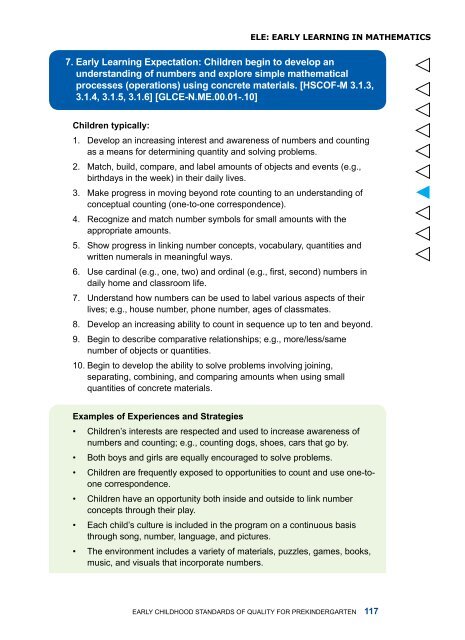Early Childhood Standards of Quality for ... - State of Michigan
Early Childhood Standards of Quality for ... - State of Michigan
Early Childhood Standards of Quality for ... - State of Michigan
Create successful ePaper yourself
Turn your PDF publications into a flip-book with our unique Google optimized e-Paper software.
ELE: early Learning in maTHEMATICS7. <strong>Early</strong> Learning Expectation: Children begin to develop anunderstanding <strong>of</strong> numbers and explore simple mathematicalprocesses (operations) using concrete materials. [HSCOF-M 3.1.3,3.1.4, 3.1.5, 3.1.6] [GLCE-N.ME.00.01-.10]Children typically:1. Develop an increasing interest and awareness <strong>of</strong> numbers and countingas a means <strong>for</strong> determining quantity and solving problems.2. Match, build, compare, and label amounts <strong>of</strong> objects and events (e.g.,birthdays in the week) in their daily lives.3. Make progress in moving beyond rote counting to an understanding <strong>of</strong>conceptual counting (one-to-one correspondence).4. Recognize and match number symbols <strong>for</strong> small amounts with theappropriate amounts.5. Show progress in linking number concepts, vocabulary, quantities andwritten numerals in meaningful ways.6. Use cardinal (e.g., one, two) and ordinal (e.g., first, second) numbers indaily home and classroom life.7. Understand how numbers can be used to label various aspects <strong>of</strong> theirlives; e.g., house number, phone number, ages <strong>of</strong> classmates.8. Develop an increasing ability to count in sequence up to ten and beyond.9. Begin to describe comparative relationships; e.g., more/less/samenumber <strong>of</strong> objects or quantities.10. Begin to develop the ability to solve problems involving joining,separating, combining, and comparing amounts when using smallquantities <strong>of</strong> concrete materials.Examples <strong>of</strong> Experiences and Strategies• Children’s interests are respected and used to increase awareness <strong>of</strong>numbers and counting; e.g., counting dogs, shoes, cars that go by.• Both boys and girls are equally encouraged to solve problems.• Children are frequently exposed to opportunities to count and use one-toonecorrespondence.• Children have an opportunity both inside and outside to link numberconcepts through their play.• Each child’s culture is included in the program on a continuous basisthrough song, number, language, and pictures.• The environment includes a variety <strong>of</strong> materials, puzzles, games, books,music, and visuals that incorporate numbers.<strong>Early</strong> <strong>Childhood</strong> <strong>Standards</strong> <strong>of</strong> <strong>Quality</strong> <strong>for</strong> Prekindergarten 117


